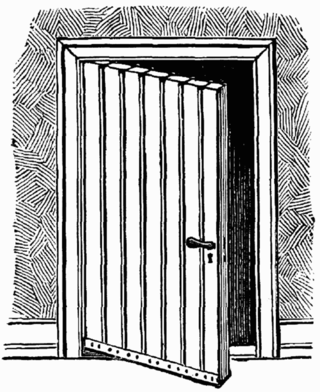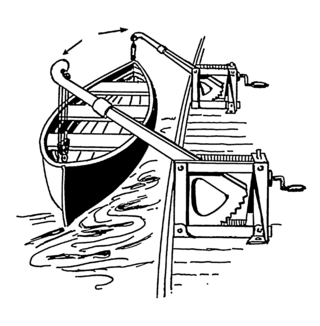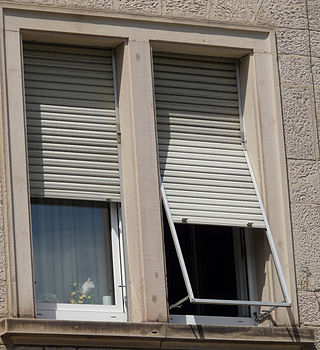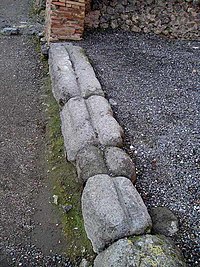
A door is a hinged or otherwise movable barrier that allows ingress (entry) into and egress (exit) from an enclosure. The created opening in the wall is a doorway or portal. A door's essential and primary purpose is to provide security by controlling access to the doorway (portal). Conventionally, it is a panel that fits into the doorway of a building, room, or vehicle. Doors are generally made of a material suited to the door's task. They are commonly attached by hinges, but can move by other means, such as slides or counterbalancing.

A cam is a rotating or sliding piece in a mechanical linkage used especially in transforming rotary motion into linear motion. It is often a part of a rotating wheel or shaft that strikes a lever at one or more points on its circular path. The cam can be a simple tooth, as is used to deliver pulses of power to a steam hammer, for example, or an eccentric disc or other shape that produces a smooth reciprocating motion in the follower, which is a lever making contact with the cam. A cam timer is similar, and were widely used for electric machine control before the advent of inexpensive electronics, microcontrollers, integrated circuits, programmable logic controllers and digital control.

A window is an opening in a wall, door, roof, or vehicle that allows the exchange of light and may also allow the passage of sound and sometimes air. Modern windows are usually glazed or covered in some other transparent or translucent material, a sash set in a frame in the opening; the sash and frame are also referred to as a window. Many glazed windows may be opened, to allow ventilation, or closed, to exclude inclement weather. Windows may have a latch or similar mechanism to lock the window shut or to hold it open by various amounts.

A roller coaster is a type of Amusement park ride employing a form of elevated track that carries passengers on a train through tight turns, steep slopes, and other elements designed to produce a thrilling experience. Trains consist of open cars connected in a single line, and the rides are often found in theme parks around the world. Roller coasters first appeared in the 17th century, and LaMarcus Adna Thompson obtained one of the first known patents for a roller coaster design in 1885, based on the Switchback Railway which opened a year earlier at Coney Island.

A window blind is a type of window covering. There are many different kinds of window blinds which use a variety of control systems. A typical window blind is made up of several long horizontal or vertical slats of various types of hard material, including wood, plastic or metal which are held together by cords that run through the blind slats. Vertical blinds run along a track system which can tilt open and closed and move side-to-side. Window blinds can be manoeuvred with either a manual or remote control by rotating them from an open position, with slats spaced out, to a closed position where slats overlap and block out most of the light. There are also several types of window coverings, called shades, that use a single piece of soft material instead of slats.

A baler or hay baler is a piece of farm machinery used to compress a cut and raked crop into compact bales that are easy to handle, transport, and store. Often, bales are configured to dry and preserve some intrinsic value of the plants bundled. Different types of balers are commonly used, each producing a different type of bale – rectangular or cylindrical, of various sizes, bound with twine, strapping, netting, or wire.

A shoji is a door, window or room divider used in traditional Japanese architecture, consisting of translucent sheets on a lattice frame. Where light transmission is not needed, the similar but opaque fusuma is used. Shoji usually slide, but may occasionally be hung or hinged, especially in more rustic styles.

A breechblock is the part of the firearm action that closes the breech of a breech loading weapon before or at the moment of firing. It seals the breech and contains the pressure generated by the ignited propellant. Retracting the breechblock allows the chamber to be loaded with a cartridge.

A lift hill, or chain hill, is an upward-sloping section of track on a roller coaster on which the roller coaster train is mechanically lifted to an elevated point or peak in the track. Upon reaching the peak, the train is then propelled from the peak by gravity and is usually allowed to coast throughout the rest of the roller coaster ride's circuit on its own momentum, including most or all of the remaining uphill sections. The initial upward-sloping section of a roller coaster track is usually a lift hill, as the train typically begins a ride with little speed, though some coasters have raised stations that permit an initial drop without a lift hill. Although uncommon, some tracks also contain multiple lift hills.

A davit is any of various crane-like devices used on a ship for supporting, raising, and lowering equipment such as boats and anchors.

The trunk or boot of a car is the vehicle's main storage or cargo compartment, often a hatch at the rear of the vehicle. It can also be called a tailgate.

A garage door is a large door to allow egress for a garage that opens either manually or by an electric motor. Garage doors are frequently large enough to accommodate automobiles and other vehicles. The operating mechanism is usually spring-loaded or counterbalanced to offset door's weight and reduce the human or motor effort required to operate the door. Less commonly, some garage doors slide or swing horizontally. Doors are made of wood, metal, or fiberglass, and may be insulated to prevent heat loss.

In architecture and construction, a sliding glass door is a type of sliding door made predominantly from glass, that is situated in an external wall to provide egress and light. The doors can give access to a backyard or patio while providing a pleasant view, and when not fully covered can be a source of passive daylighting. Like a window, when open it also provides fresh air and copious natural light. It is considered a single unit consisting of two or more panel sections, some or all being mobile to slide open. Another design, a wall-sized glass pocket door has one or more panels movable and sliding into wall pockets, completely disappearing for a 'wide open' indoor-outdoor room experience.

A drawer is a box-shaped container inside a piece of furniture that can be pulled out horizontally to access its contents. Drawers are built into numerous types of furniture, including cabinets, chests of drawers (bureaus), desks, and the like.

A car door is a type of door opening, typically hinged on its front edge, but sometimes attached by other mechanisms such as tracks, for entering and exiting a vehicle. Doors most often integrate side windows for visibility from inside the car and can be locked to secure the vehicle.

A stairclimber is a type of trolley fitted with rotating wheels or tracks so that it can be pushed or pulled up or down steps or a stairway. Stairclimbers can be manual or battery-powered, and are commonly found in wheel, track, push arm or walker variants.

Material handling equipment (MHE) is mechanical equipment used for the movement, storage, control, and protection of materials, goods and products throughout the process of manufacturing, distribution, consumption, and disposal. The different types of equipment can be classified into four major categories: transport equipment, positioning equipment, unit load formation equipment, and storage equipment.

A conveyor system is a common piece of mechanical handling equipment that moves materials from one location to another. Conveyors are especially useful in applications involving the transport of heavy or bulky materials. Conveyor systems allow quick and efficient transport for a wide variety of materials, which make them very popular in the material handling and packaging industries. They also have popular consumer applications, as they are often found in supermarkets and airports, constituting the final leg of item/ bag delivery to customers. Many kinds of conveying systems are available and are used according to the various needs of different industries. There are chain conveyors as well. Chain conveyors consist of enclosed tracks, I-Beam, towline, power & free, and hand pushed trolleys.

A sliding door is a type of door that is mounted on or suspended from a track for the door to slide, usually horizontally and outside. It is a feature predominantly found in minibuses, buses, and vans, so as to allow a large unobstructed access to the interior for loading and unloading of passengers or cargo without the doors interfering with adjacent space.

A roller shutter, security shutter, coiling door, roller door or sectional overhead door is a specialized type of door or window shutter consisting of multiple horizontal slats, bars, or web systems interconnected through hinges. The mechanism involves lifting the door to open it and lowering it to close. In the case of larger doors, an automated, motorized system may be employed.























